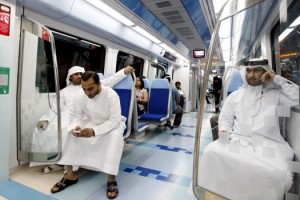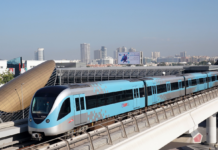By Tom Hundley www.globalpost.com
DUBAI, United Arab Emirates — When his kingdom’s roads became so swollen with assorted Mercedes and Hummers that even short trips across town turned into slow motion marathons, His Highness Sheikh Mohammed al Maktoum, the ruler (and unofficial CEO) of Dubai, decreed that a metro be built.

Three-and-a-half years and $7.6 billion later, Sheikh Mohammed, resplendent in royal blue robes and accompanied by the usual pomp and glitz, became the first passenger on the Arabian Peninsula’s first rapid rail transit system.
Built by a Japanese consortium and operated by a British contractor, the fully automated system is technologically and aesthetically dazzling. Its driverless, air-conditioned trains glide silently and serenely along elevated tracks through most of the city before dipping underground in the crowded center.
Only 10 of the inaugural line’s 29 gold-skinned stations were ready for the Sept. 9 grand opening — the rest are supposed to open next year — so it is too early to tell if Dubai’s shiny new train set can persuade the locals to leave their cars in the garage.
But one thing is clear: The metro has already upset the applecart of this rich Emirate’s rigid social hierarchy.
Dubai is a city that caters to the ostentatiously wealthy. Like any arriviste, it has a constant need to puff up its ego with outlandish superlatives — the world’s tallest building, the world’s most luxurious hotel, the world’s fanciest shopping mall. A man-made archipelago, shaped like a palm tree and loaded with luxury villas, is the signature symbol of Dubai’s devotion to showy opulence.
The metro is different. No velvet rope or electrified security gate to keep out the masses. And in the few weeks since it began running, the new ride has turned into something of social leveler: privileged Emiratis suddenly find themselves in the unfamiliar position of competing for rush-hour seats with their Filipina housemaids.
Dubai likes to think of itself as a cosmopolitan place. And it is true, many nationalities do coexist here, but they rarely mingle. More often, the different social strata view each other with scarcely veiled disdain.
At the top of the totem pole are the Emiratis. A minority in their own gilded city-state, they represent only 17 percent of the total population of 1.4 million. Cosseted from cradle to grave by a generous welfare state, they tend to exude a certain to-the-manor-born aloofness.
Next are the expats, mainly Brits, but with a smattering of other Europeans, Australians and North Americans. They, too, manage an air of entitlement.
Below them are the small businessmen and professionals from elsewhere in the Middle East and the Asian subcontinent. They’ve come here to cash in, but usually without the gaudy benefit packages that Western expats claim as their due.
The largest group, more than 70 percent of the population, is the construction workers, housemaids, hotel help, shop clerks, taxi drivers, gardeners and street sweepers who have built the city and keep it running smoothly. They come from poor countries in Asia and live here in a kind of indentured servitude.
But a ticket on the metro costs the same for all — less than fifty cents for short hops in the city center, increasing incrementally for longer rides.
In a nod to the local fetish for luxury and exclusivity, the metro does provide “Gold Class” service where, for double the price, the aristocracy can take refuge from the sweating masses. Gold Class offers a separate car with nicely padded leather seats, but without the “I Dream of Jeannie” cabin attendants familiar to passengers on the national airline.
Gold Class does have its clientele — mainly Emirati men wearing traditional white thobes and headdresses, often accompanied by their veiled wives, children and household retainers. But most locals seem happy enough to mix it up with the rest of us in standard class.
There’s also a separate compartment for women and children. Some women use it, especially when the trains are crowded, but the segregated compartments seem to be there to appease those (male) guardians of public morality who believe it is unwholesome for a woman to sit or stand in close proximity to any man not related to her.
I saw one of these self-appointed upholders of virtue trying to shoo two teenage girls into the women’s compartment. The girls, who were wearing sleeveless tops, common in Dubai, wouldn’t budge.
I have also seen unexpected acts of chivalry: a man offers his seat to a young mother, for example. It is a normal courtesy on the London Tube or the Paris Metro perhaps, but here, where there is little experience with straphangers’ etiquette, the ordinary rituals of civility are not yet second nature.
When Dubai has something new to show the world, it usually rolls out the superlatives. The world’s tallest, the most exclusive, the most luxurious. No expense was spared in the ad campaign for the new metro, but the tone was decidedly low key and egalitarian: “My City. My Metro.”
According to its creator, the Saatchi & Saatchi ad agency, the idea is to foster a sense of civic pride and ownership that cuts across social barriers. If that notion takes root, Dubai will have gained something far more valuable than a shiny new train set.

















